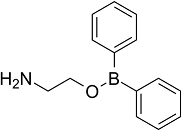All AbMole products are for research use only, cannot be used for human consumption.

2-Aminoethyl diphenylborinate (2-APB) is a cell-permeable inhibitor of IP3R, and regulate IP3-induced calcium release. 2-Aminoethyl diphenylborinate (2-APB) inhibits the SOC channel activity and activates TRP channel at higher concentrations.
DPBA staining solution preparation
Reagent Amount for 100 ml
2-Aminoethyl diphenylborinate (DPBA) 0.25 g
Triton X-100 20 μl
Milli-Q water up to 100 ml
Notes:
a. Some crystals of DPBA can be retained and seen after mixing.
b. This staining solution can be stored at -20 °C for further uses.
Equipment
1. Tweezers
2. A plant growth chamber
3. Micro-tubes rotator
4. Pipette
5. Confocal microscopy system
Plant growth and DPBA staining procedure
1. Here, Arabidopsis thaliana is used. However, this protocol can be applied for other plants as well. Grow plants on MS medium supplemented with 2% sucrose and 1.2% phyto-agar for 5 days. The growth chamber conditions were 22 ± 1 °C, long-day (16 h light/8 h dark), and light intensity 100 μmol m-2 s-1.
Note: After seeding, remember to place the medium plates vertically in the growth chamber. Thereby, the roots grow on the surface of the medium and intact root tip samples can be obtained.
2. Add 1 ml of DPBA staining solution (Recipe 1) to each micro-tube.
3. Use a clean tweezers to carefully transfer the 5-day-old Arabidopsis seedlings to the micro-tube containing DPBA staining solution (5 seedlings/micro-tube).
4. Place the micro-tube in the rotator and rotate for 5 min at room temperature.
5. Stop the rotator, transfer the micro-tube to a rack and remove the DPBA staining solution.
Note: At this step, carefully use a pipette to remove the DPBA staining solution and try to not damage the plants, especially the root tips.
6. For washing, add 1.5 ml of distilled water to each micro-tube. Place the micro-tube in the rotator and rotate for 2 min at room temperature.
7. Stop the rotator, transfer the micro-tube to a rack and remove water.
8. Repeat Steps A6 and A7 two more times.
Note: After washing, can keep the plants in water and try to detect immediately. Do not leave the samples staying in water for longer than 30 min.
9. Transfer the seedlings to a microscope slide, cover it and detect the flavonols accumulation in the root tips by a confocal microscope.
Confocal microscopy
1. For DPBA-kaempferol, apply the emission spectrum (475-500 nm).
2. For DPBA-quercetin, apply the emission spectrum (585-619 nm).
3. Remember to take an additional bright field picture for control.
| Molecular Weight | 225.09 |
| Formula | C14H16BNO |
| CAS Number | 524-95-8 |
| Solubility (25°C) | DMSO ≥ 100 mg/mL |
| Storage |
Powder -20°C 3 years ; 4°C 2 years In solvent -80°C 6 months ; -20°C 1 month |
| Related Calcium Channel Products |
|---|
| CBD3063
CBD3063 is a selective, first-in-class, CRMP2-based peptidomimetic small molecule, which allosterically regulates Cav2.2 to achieve analgesia and pain relief without negative side effect profiles. |
| TTA-A8
TTA-A8 is a short-acting T-type calcium channel antagonist with oral activity, exhibiting an IC50 value of 31.3 nM in the FLIPR depolarization assay. |
| MONIRO-1
MONIRO-1 is a T-type and N-type calcium channel blocker with IC50 values of 34, 3.3, 1.7 and 7.2 µM against hCav2.2, hCav3.1, hCav3.2 and hCav3.3, respectively. |
| Azumolene
Azumolene (EU4093 free base), a Dantrolene analog, is a muscle relaxant. |
| Nexopamil
Nexopamil is a calcium antagonist of Ca2+ channel, 5HT2, 5HT1A, 5HT1C and dopamine D2 receptors. |
All AbMole products are for research use only, cannot be used for human consumption or veterinary use. We do not provide products or services to individuals. Please comply with the intended use and do not use AbMole products for any other purpose.


Products are for research use only. Not for human use. We do not sell to patients.
© Copyright 2010-2024 AbMole BioScience. All Rights Reserved.
